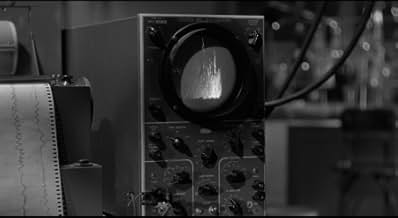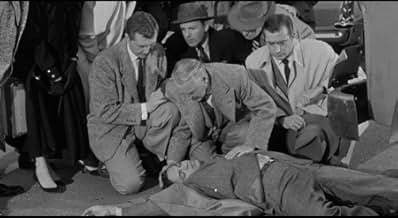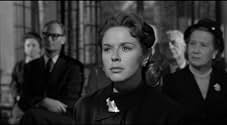NOTE IMDb
5,9/10
1,4 k
MA NOTE
Ajouter une intrigue dans votre langueA brilliant surgeon encases his dead son's brain in a large robot body, with unintended results...A brilliant surgeon encases his dead son's brain in a large robot body, with unintended results...A brilliant surgeon encases his dead son's brain in a large robot body, with unintended results...
- Réalisation
- Scénario
- Casting principal
George Douglas
- Official
- (non crédité)
Roy Engel
- Police Inspector
- (non crédité)
Sam Harris
- Man at Funeral Service
- (non crédité)
Larry Kerr
- Reporter
- (non crédité)
Harold Miller
- Airport Accident Extra
- (non crédité)
Dick Nelson
- Charles - Chauffeur-Butler
- (non crédité)
Foster H. Phinney
- Reporter
- (non crédité)
Jack Richardson
- Reporter
- (non crédité)
Court Shepard
- Reporter
- (non crédité)
Charles Sherlock
- Airline Pilot
- (non crédité)
Bert Stevens
- Airport Accident Extra
- (non crédité)
Avis à la une
Despite some clunky moments I still think the best and most eerie part of Colussus of new york is when the "dead" scientist awakes, and gradually with mounting terror, realises his brain is in the body of a robot! This scene I'm sure influenced Director Paul Verhoeven when he made "Robocop" many years later. look at the creepy visuals in this scene as we see everything from the robots P.O.V and note that its visualisation is similar to what you see on an old Television monitor. those lines spoken by his creator "you can see, you can hear, you can speak and you can move" still sends a chill down my spine. I rate this as one of the best eerie mad lab scenes in the movies.
"The Colossus of New York" has aged rather well. It still evokes the same strange fascination it had back in the late 1950s, when its story and title character startled me. It was evident back then that the film was a low-budget production, and that it was not a masterpiece of fantastic cinema, but its variation of the theme of the scientist that creates a monster was interesting, and the appearance of the colossus was impressive. I have read a couple of commentaries from producer William Alland, in which he expressed that he was very unsatisfied with the results, and put all the blame on Eugène Lourié. Allan definitely did not paid too much attention to the limitations of the budget he administered –forcing to reuse shots, and the inclusion of stock footage-, of Thelma Schnee's weak script, or the negligence of Floyd Knudtson's editing. But especially, Alland overlooked John F. Warren's images, some of which are remarkable. This is also due to Lourié's background: he was originally an art director and set designer, and it shows. The lightning, compositions and camera angles are effective most of the times, and compensate for the shortcomings. Where Lourié's lack of expertise shows is in the routine camera set-ups, putting the camera (and the spectator) in the same position, in scenes that take place in the same locations, but separate in time. This somehow makes the movie unfold too cautiously, an explanation to the speed up of some shots when the colossus moves. Otherwise it is a recommended, little cult film that will stick to your memory.
An elderly doctor (Otto Kruger) transplants his genius son's brain inside the head of an over-sized robot after the young scientist is killed in an auto accident. The revitalized Colossus retains our sympathy but eventually grows somewhat mad and kills people by shooting them with rays from out of his eye fixtures. I must say that even though I don't typically get scared watching horror movies, the very first time I heard the robot's unhinged and desperately static-tinged voice as he's being given life, it sent absolute shivers of discomfort down my spine - I was terrified! I liked the look of the robot, and the unnatural way he's sometimes photographed jerkily lumbering along (which sometimes sloppily reflected the other characters' motions in the same scenes). Just really creepy. If they could have consistently managed to photograph the other people's reactionary movements at "normal pace" while the robot only was moving awkwardly, it would have been even more weirdly effective. The production values are very cheap, and there is only a modest piano soundtrack to accompany the activities, yet somehow it all works out effectively enough for this movie. Old man Otto Kruger was probably embarrassed to be acting in this, but I enjoyed him here just as I enjoyed his turn as a mad doc in THE JUNGLE CAPTIVE. This movie's also got unintentional chuckles, too (I was in hysterics at Kruger's silly looking-down expression at the United Nations of the film when his robot meets its fate). Fun low budgeted '50s Flick, now one of my favorites from the genre. **1/2 out of ****
Contrary to what some critics and viewers may say, THE COLOSSUS OF NEW YORK was actually quite dark and atmospheric! This was an exemplary modern-day take on the "Frankenstein's Monster" theme! The performances were well-done, the solo-piano music by Van Cleave was brilliant, and the Colossus itself was actually well created for its time. Even the climax, no matter how "cliched" by today's standard, is still poignant.
I definitely reccommend this movie! I think it deserves to be on DVD as well!
-John Cassidy
I definitely reccommend this movie! I think it deserves to be on DVD as well!
-John Cassidy
The conventional wisdom is that this is a mediocre movie. Yet I find it strangely affecting. A man's brain is placed in a large robotic body, but it's not the usual mad scientist bit. The scientist is a desperate father and the brain belongs to his son (Ross Martin), killed(?) in an automobile accident.
Encased in his robotic body, the son longs to see his own son. These are mad scientists with family values!
The only music in the movie is provided by a lone piano. The motivation for this decision was probably more economical than artistic but Nathan Van Cleave's score echoes the fear and melancholy that permeates the film perfectly.
Not a great film, but one every sci-fi and horror movie fan should see.
Encased in his robotic body, the son longs to see his own son. These are mad scientists with family values!
The only music in the movie is provided by a lone piano. The motivation for this decision was probably more economical than artistic but Nathan Van Cleave's score echoes the fear and melancholy that permeates the film perfectly.
Not a great film, but one every sci-fi and horror movie fan should see.
Le saviez-vous
- AnecdotesThe Colossus costume was eight feet tall, weighed 160 pounds and was made from burlap, plastic, rubber and fine chicken wire. Inside, there were batteries, cables, air tanks and oxygen tubes.
- GaffesWhen Jeremy (the Colossus) crashes through the glass wall at the end of the movie, the very next scene there is a woman lying on the floor and the man to the left of her looks down at her. In the scene following, the Colossus starts shooting eye beams. The eye beam then hits the woman, now standing, and she falls to the floor, in the same position.
- Crédits fousThe opening credits text rises out of New York harbor, as its reflection on the water sinks to the bottom of the screen.
Meilleurs choix
Connectez-vous pour évaluer et suivre la liste de favoris afin de recevoir des recommandations personnalisées
- How long is The Colossus of New York?Alimenté par Alexa
Détails
- Date de sortie
- Pays d’origine
- Langue
- Aussi connu sous le nom de
- The Colossus of New York
- Lieux de tournage
- Société de production
- Voir plus de crédits d'entreprise sur IMDbPro
- Durée1 heure 10 minutes
- Couleur
- Rapport de forme
- 1.66 : 1
Contribuer à cette page
Suggérer une modification ou ajouter du contenu manquant

Lacune principale
By what name was Le colosse de New York (1958) officially released in Canada in English?
Répondre































